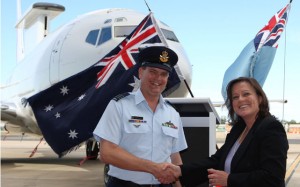
The RAAF formally took delivery of the first two of six Boeing 737 Wedgetail AEW&C aircraft at a ceremony at RAAF Williamtown on May 5.
The official handover has seen the two aircraft brought onto the RAAF’s register with 2SQN, a large proportion of the project’s contracted fees paid to Boeing, and comes six months after an ‘initial’ handover took place late last year. Following that initial handover, the aircraft remained on the US civil register and Boeing test crews had been required to fly with and oversee maintenance work on the aircraft at all times, while RAAF crews trained and conducted operational test work.
“The Wedgetail project has suffered problems, especially in regards to schedule, and has been on the government’s ‘projects of concern’ list,” said Minister for Defence Materiel and Science. Greg Combet. “This project was experiencing a variety of problems when the government was elected but we have put a lot of work into getting it back on track. Over a decade since the project first started it is finally now ready to be used for Air Force training. I congratulate all parties, including the Department, Air Force and the Wedgetail’s manufacturer Boeing who have got us to this point. This is good news, although there are still a number of hurdles to overcome. Defence will continue to work alongside Boeing to support the ramp up of training and the final delivery of all six completed aircraft.”
The Wedgetail project is running nearly four years late after development and integration problems with the aircraft’s revolutionary MESA radar system. Three more Wedgetails are due to be delivered by the end of 2010 and the final aircraft early next year.
Ongoing work is still being conducted on the aircraft’s ESM system and its integration with the MESA radar. The final four aircraft all should have their ESM systems fitted and integrated at delivery, while the first two aircraft will have their systems activated and configured in 2011.
Projected full operational capability for the Wedgetail fleet is projected to be realised in late 2012.












